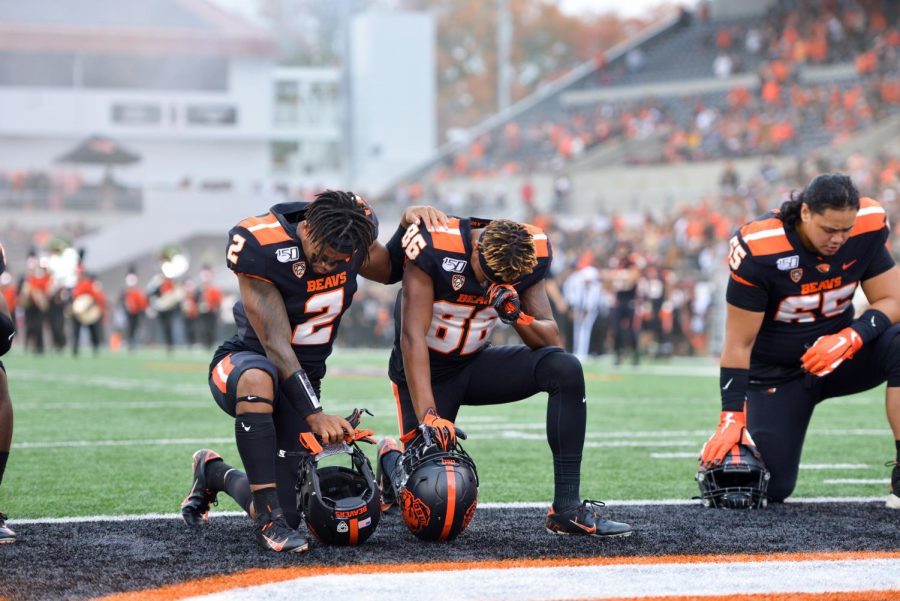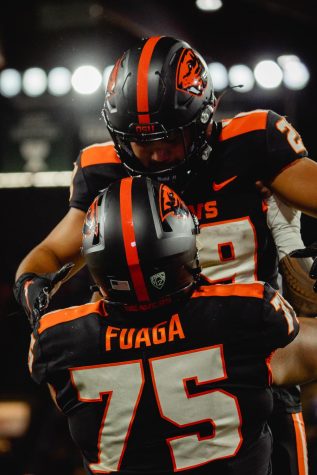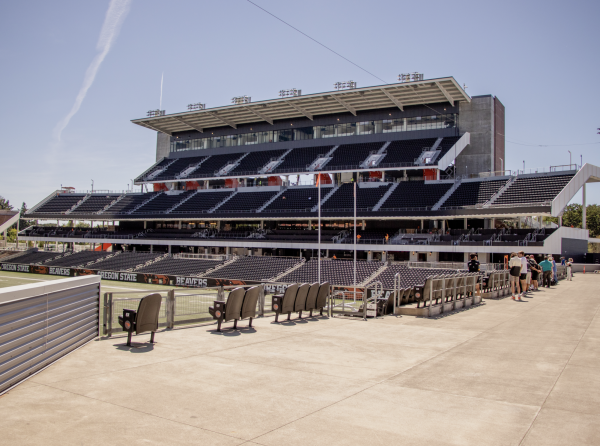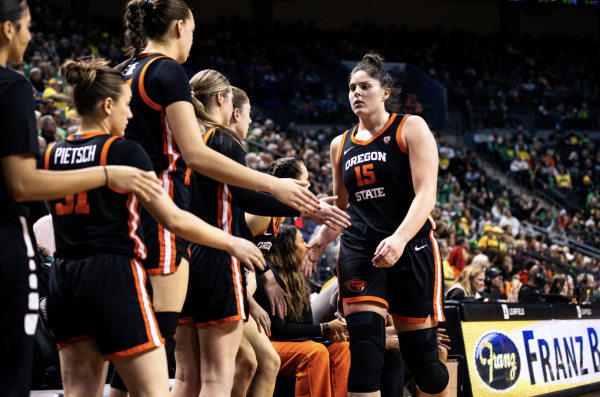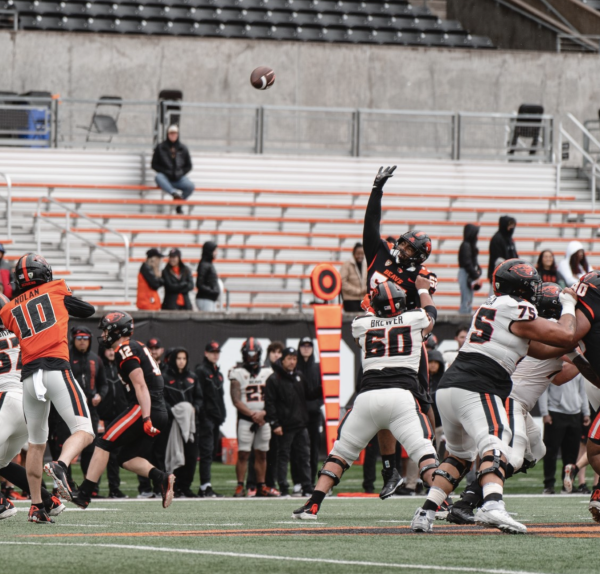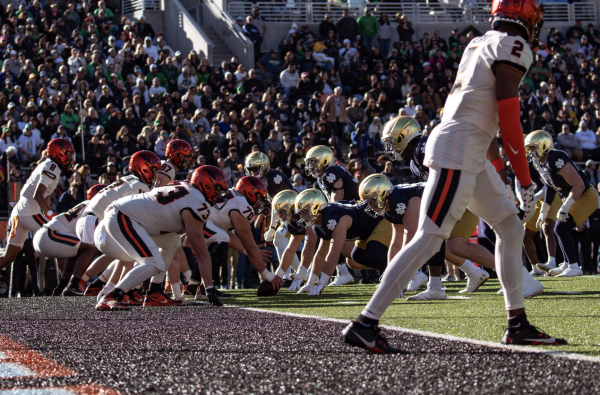Injury Riddled Beavers Fail to Complete Comeback against the Utah Utes
December 7, 2020
Coming off a two-game win streak but riddled with unavailable players, the Oregon State Beavers failed to finish off a late comeback against the then-winless Utah Utes on Dec. 5 in Salt Lake City.
The final score was 30-24 as the Beavers’ late comeback in the final quarter came up short. Oregon State had been down 30-10 with 14 minutes left in the fourth quarter, with the team struggling on both sides of the ball up to that point.
The offense struggled to get going in the absence of starting running back and PAC-12 leading rusher Jermar Jefferson, who was ruled out hours before the game due to COVID-19 protocols, and starting quarterback Tristan Gebbia, who was out due to a leg injury suffered late in the previous week’s win against the Oregon Ducks. Things were made worse when junior running back BJ Baylor was injured in the first quarter and junior wide receiver Champ Flemings exited the game with an injury later on as well.
Thus, Oregon State had to depend on the inexperienced junior Calvin Tyler Jr. at running back for most of the game, along with quarterback Chance Nolan. Before the game against Utah, Tyler Jr. had not had a carry in the 2020 season, while Nolan had only taken one snap all season. Despite this, the Beavers seemed to be unfazed. In particular, junior linebacker Avery Roberts was unwilling to let injury absences go as an excuse.
“Everyone prepares. Next guy up,” Roberts said. “Any week, especially with COVID-19, you never know who’s going to be up. Everyone has to be ready to play.”
Despite this positive mindset, the Beavers clearly struggled to overcome the inexperience on the field early in the game. The team picked up 154 yards and scored 10 points through the first three-quarters of the game, their lowest marks of the season.
Nolan’s very first pass attempt was an interception, the leading rusher for the team on the game was gadget short-yardage quarterback/converted linebacker Jack Colletto, who broke off for a 40-yard run on his only carry of the game, the team went 2 for 13 on third down, and the Beavers only touchdown drive in the first three quarters was aided by four penalties from the Utes defense.
Nolan could not help but blame himself for the early game struggles. The redshirt sophomore quarterback was making his first start at the FBS level against the Utes, and blamed jitters in part for some shaky early-game moments.
“I left a lot of stuff on the field,” Nolan saidl. “I think I just was maybe a little anxious. I was leading my receivers a little too far and I left one high to my tight end early on a big third-down we should have had back for a conversion. I think, yeah, I was just a little anxious. I started settling down in the second half though for sure.”
With the availability of the offense’s stars in Gebbia, Jefferson, and Baylor unknown for the rest of the season, the performance of Nolan, the top-rated dual-threat JUCO quarterback prospect in the country last year, will be important in the games to come. Head Coach Jonathan Smith seemed to agree with his quarterback’s assessment of his own performance. He acknowledged that there was room for improvement but also praised the performance in context.
“For a first start coming over here and playing this defense, we knew it was going to be a challenge,” said Smith. “I did think he continued to get into the flow of the game, but he needed to be more accurate at times and I think he’ll tell you that himself. But, shoot, he played well enough to keep us in the game with the ball at the end of the game. I know he will learn a bunch from this, he’ll dive into [the] film, and having a first experience like this we’re counting on a big jump in game two for him.”
The Oregon State defense similarly struggled in the early parts of the game. They were unable to force a punt from the Utes’ offense until late in the third quarter, and freshman running back Ty Jordan gashed them for 167 yards and a touchdown on the ground. Roberts expressed frustration from the defensive effort after the game. Despite the linebacker’s career-high 21 tackles, he felt that he, along with the defense as a whole, should have executed at a higher level.
“We knew what they were going to run but we just didn’t execute and it showed,” Roberts said. “I can only speak for myself but I probably played my worst game of the season. Missed tackles, just got played out there assignment-wise. I just didn’t execute the way I was supposed to.”
Despite this difficulty stopping the Utes from putting together long drives, the defense was still able to clamp down once Utah was in the red zone, holding the Utes to field goals on their first three drives. And on Utah’s second scoring drive, one that was set up by the interception from Nolan, the Utes gained possession on the Oregon State 10-yard line. But the defense held strong, and held Utah to a three and out to force the field goal.
But while Utah was ending their with field goals, Oregon State’s special teams’’ group struggled as a whole. The Beavers missed a 50-yard field goal in the first quarter and having a punt returned for a touchdown early in the fourth quarter which is what set up the 30-10 lead for the Utes. From this point forward though, the Beavers played well in all three phases, continuing their trend from both wins this season of turning up late in games and staging a comeback.
“Every game will come down to the fourth quarter,” said Roberts. “Doesn’t matter what the score is early. We know at the end it’s going to come down to the 4th quarter. Whether you’re up or down you just have to keep playing.”
And keep playing they did. Led by Roberts, the defense held the Utes without a first down in the fourth quarter, helping to keep the Beavers within the game and give the offense a chance to win. Smith was impressed by that performance from the defense but pointed out that there was much to improve on regardless.
“That part was good,” said Smith about the defense’s late stops. “We needed some stops and they came up big. Needed to sort some things out. In the first half Utah was moving the ball really well and we held them to some field goals that kept the game close. At the same time though, we gotta create some turnovers. We had some opportunities…Utah definitely had one that turned into three points for them and then they had the huge turn on the punt return. We didn’t have the same type of plays, getting turnovers and on special teams.”
The Oregon State offense kept playing hard and improving in the fourth quarter. They picked up more yards and points in the 4th quarter than the whole rest of the game, with 181 yards and 14 points. The last-minute push was led by Nolan, who seemed to have gotten settled in and threaded a beautiful 21-yard pass through traffic to Kolby Taylor to put the game within one possession.
“I never thought we were out of the game,” said Nolan when asked about that moment. “20 points isn’t a big thing to come back from. At that point we just had to get a stop and do it again. We fell short but um…that’s football.”
Two late drives from the Beavers when they were only down by six points ended a couple of yards short on fourth down in the Utes territory and thus guaranteed a loss for the Beavers, snapping a two-game win streak and putting them below .500 once again at a record of 2-3. They’ll need to win their last two games this season in order to be bowl eligible for the first time since 2013. The Utes, meanwhile, got their first win in 371 days to move to 1-2 on the season.
The Beavers will look to get back on the win column again next Saturday, Dec. 12 against the Stanford Cardinal in Corvallis, as the game had to be moved away from Stanford’s home county due to COVID-19 protocols there.












































































































